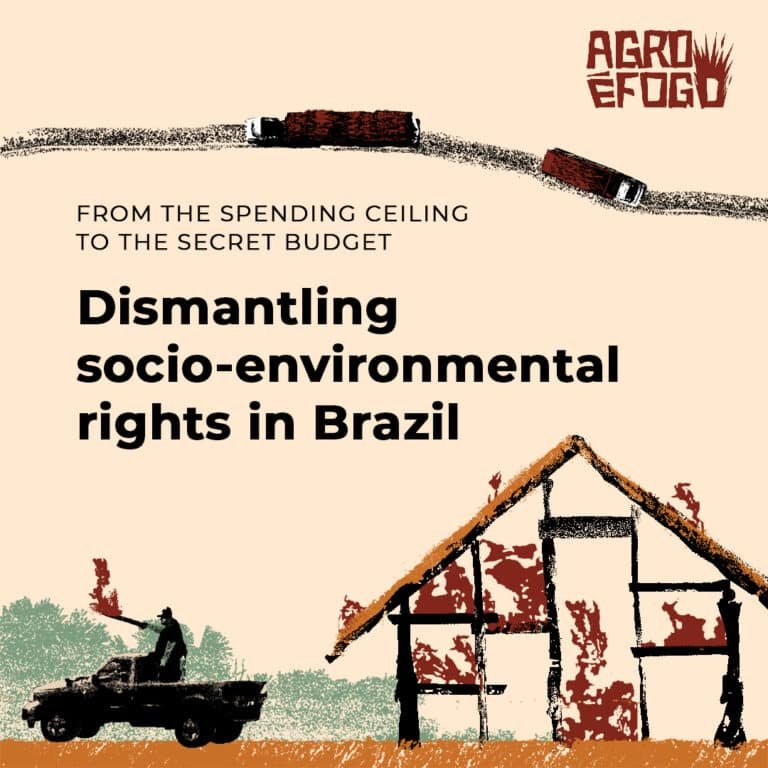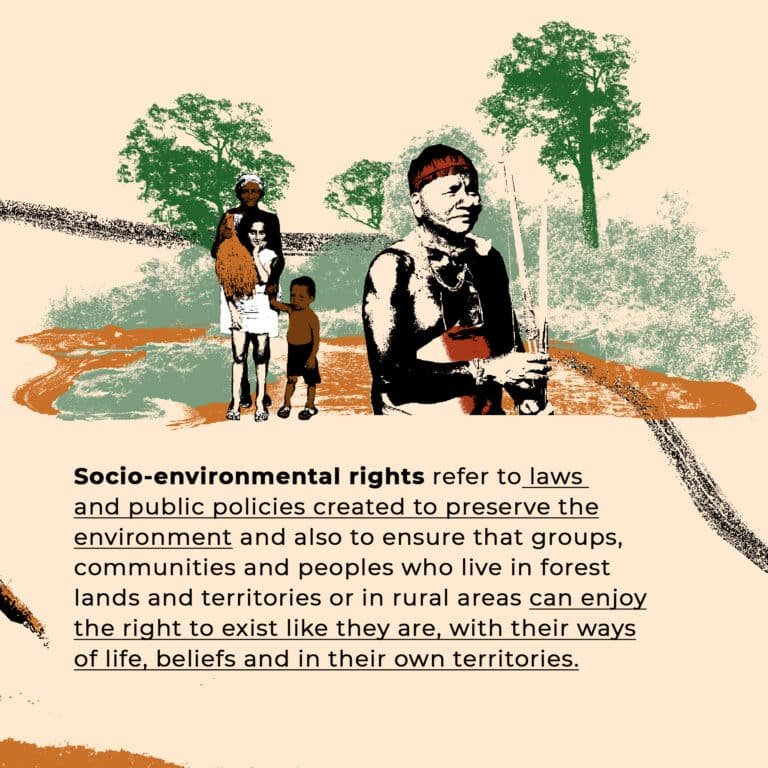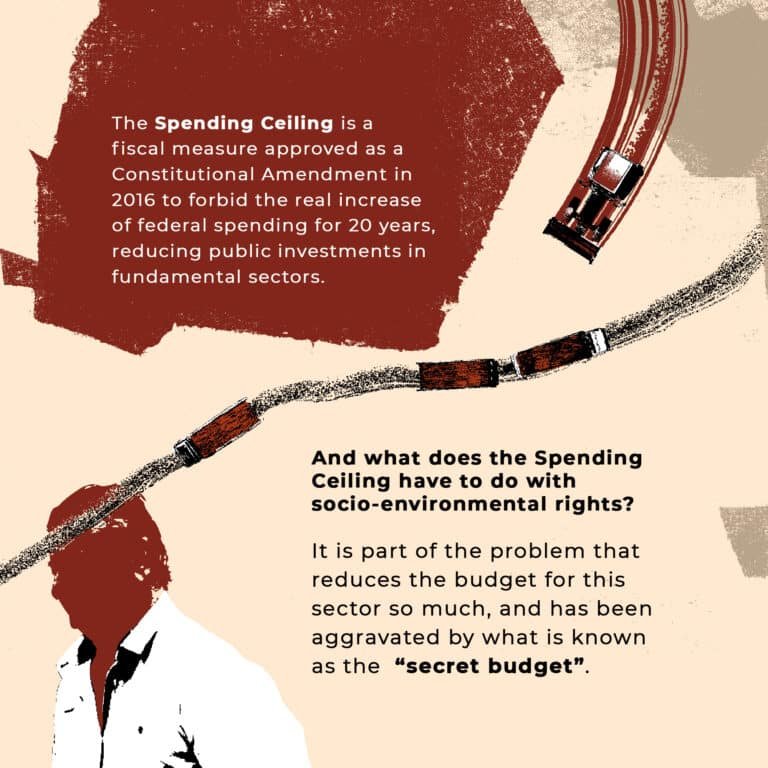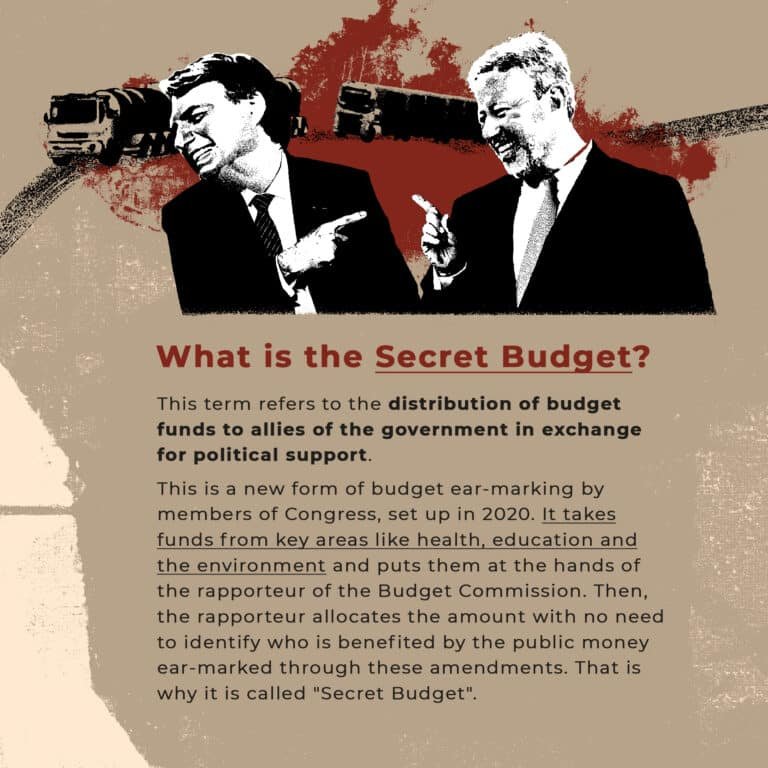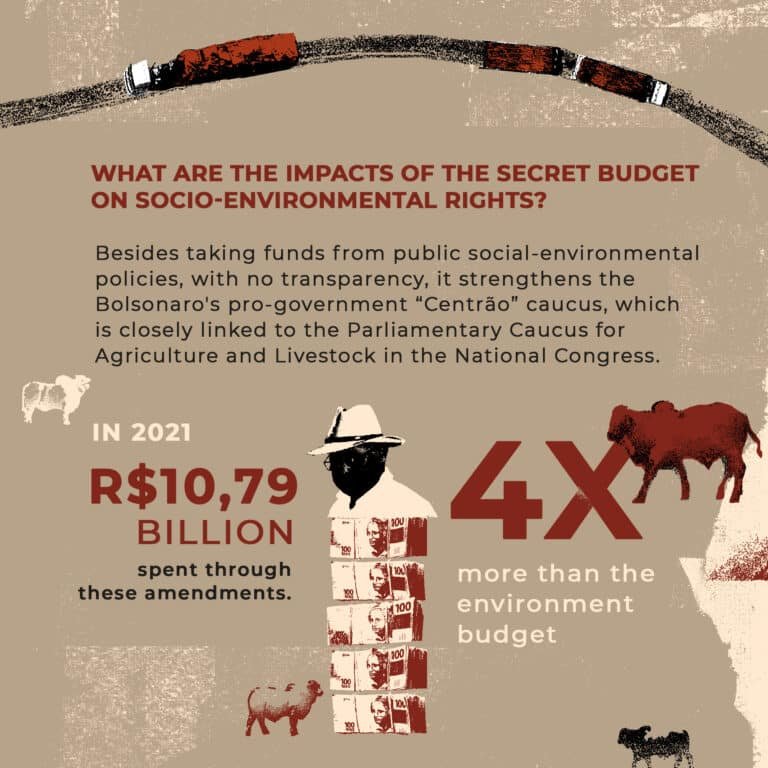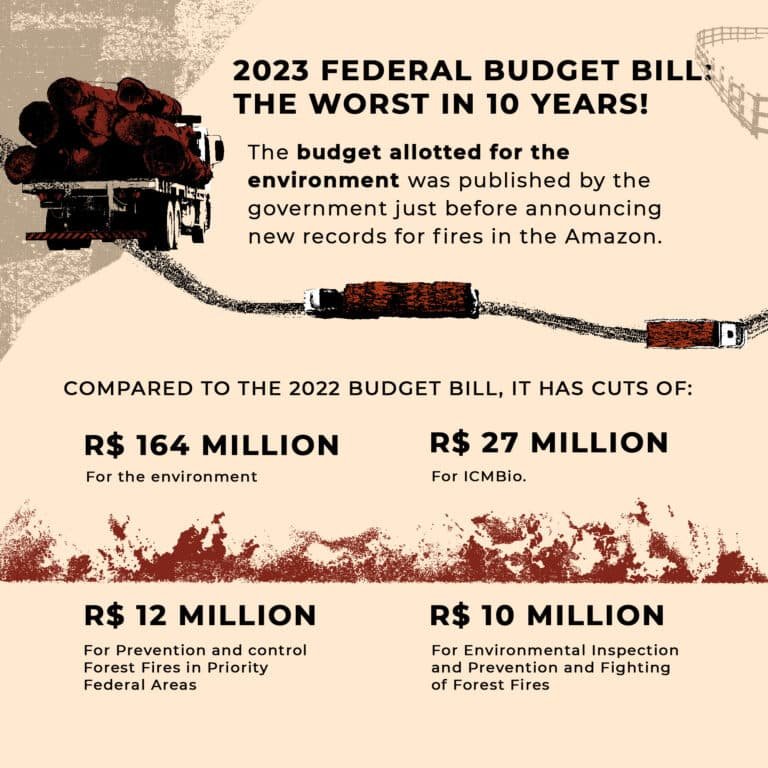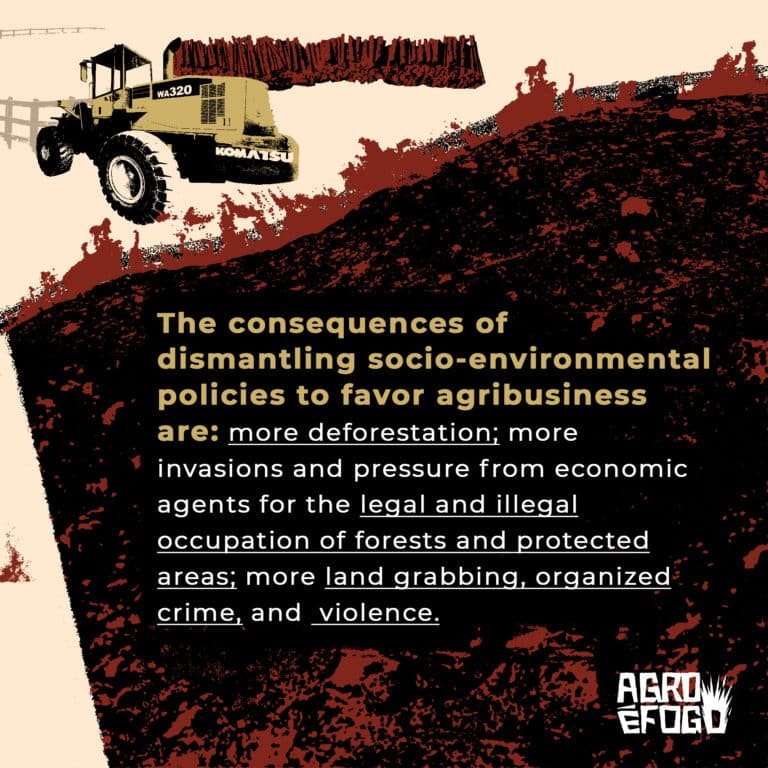Socio-environmental policies: from dismantling to the challenges of recovery
by By Alessandra Cardoso and Nathalie Beghin
Since 2019, we have witnessed the dismantling of socio-environmental rights in Brazil, in both the broad and a stricter sense. By socio-environmental rights in the broad sense we refer to a complex network of environmental and social rights, ranging from health, education, social assistance, public safety, and culture to infrastructure policies. Our entire existence as human beings can and must be seen from a social and environmental perspective. We are part of nature. The term is, therefore, a key that allows us to interpret a variety of themes that shape a political and spatial perspective for analyzing public budgets in the light of what we call socio-environmental rights. By socio-environmental rights in the strict sense we refer to laws and public policies established to preserve the environment and also to ensure that groups, communities, and peoples living in forests or rural lands and territories can enjoy the right to be as they are, with their ways of life, livelihoods, beliefs, and in their own territories.
Brazil’s socio-environmental policies[1] have been dismantled by direct, indirect, hidden and symbolic changes that have meant cuts, reductions or even the abolition of budgets, rules, institutional capacities and public policy instruments[2].
Such a breakdown of socio-environmental policy, in the strict sense, has taken the explicit form of several infra-legal measures – Ordinances, Normative Instructions, and Decrees[3] – and legal steps such as the weakening of environmental, indigenous, and land tenure institutions, obstruction of participatory bodies, paralysis of socio-environmental funds, and severe budget cuts.
The overall collapse of budgets has been closely monitored by the Institute for Socioeconomic Studies, Inesc (Instituto de Estudos Socioeconômicos). It works in tandem with a broader breakdown intimately related to the growth of deforestation and to pressure from economic agents for illegal and legal encroachments on forests and protected areas, through more land grabbing, organized crime, and violence. This all amounts to severe non-compliance, by Brazil, with its own constitutional norms and national laws, which are widely recognized – nationally and internationally – as leading edge for the world, composed of international agreements, and public policies rooted in a sizable framework of environmental protection and territorial rights.
Notes
As we have shown in analyses published by Inesc on the Federal Government Financial Statements
– Balanço Geral da União, BGU.
Bauer, M. et al. (2012). Dismantling Public Policy. Preferences, Strategies and Effects. Oxford, Oxford University Press.
As the Minister of the Environment Ricardo Salles put it, this means “driving the herd through” while the gate is open. Salles used the expression to refer to the policy of destruction of all protection measures and environmental control to facilitate deforestation and the encroachment on protected areas.
It is true that enforcement of socio-environmental rights has never been a priority on the agenda of successive governments. It is also true, however, that their status has progressed from non-priority items to becoming the prey of environmentally racist government policies at the service of land-grabbing strategies subservient to agribusiness, in its many idiosyncratic and intertwined variants.
Data on the evolution of farmland planted with grains show that, in the last three crop years, an additional 7.9 million hectares of land were incorporated. The impact of this dynamic is clear, among many other factors, in the acceleration of deforestation rates in the last three years. From August 2021 to July 2022, data from DETER (Deforestation Detection in Real Time) shows the clearing of 8,590.33 km2 in the Amazon and 5,426.4 km2 in the Cerrado. In the Atlantic Forest, which still has just over 12% of its original cover, in the first half of 2022 alone data from the SAD (Deforestation Alert System) detected the loss of another 213 million m2.
In our view, successive public budget cuts for socio-environmental policies express and should be interpreted as one dimension of this dismantling. It must be said, however, that part of the federal budget reductions should be credited to the socalled “Spending Ceiling”. This fiscal measure, approved in 2016 as an amendment to the Constitution, makes real spending growth impossible for 20 years, and reduces public investment in key sectors.
More recently, the problem has been further aggravated by a so-called “secret budget”. This refers to funds earmarked through amendments by the congressional rapporteur for the overall federal budget. In 2021, total spending on these amendments (R$10.79 billion) was more than four times the amount spent on the environment budget for the same year. The secret budget disputes resources with socio-environmental public policies and has being carried out with no transparency at all, but not only. It also favors the so-called “centrão”, a loose coalition which to a large degree overlaps with the Parliamentary Caucus for Agriculture and Livestock, composed of right-wing landowners and agribusiness representatives in the National Congress.
Dismantling environmental policies
If we look more narrowly at environmental policies – which are only one part of socio-environmental policies – we observe how the paltry amounts spent on the environment add up to a wasteland scenario. In the year 2021, the federal government spent only R$2.49 billion for all of its environmental agencies (Ministry of the Environment, Ibama, ICMBio, Botanical Garden). As total spending falls, relatively rigid personnel expenses come to account for a larger share: in 2021, for example, 71% of the environmental agencies’ expenditures were earmarked for personnel. In contrast, funds allocated for environmental purpose activities were only R$615 million, less than half the amount spent in 2014.
Aside from the budget collapse, the weakening of environmental agencies’ staffing, the regulatory breakdown, and political appointments of so many people with no technical qualifications to posts make things even worse. The result is a budget for the environment that, in addition to being meager itself, is further impaired by the lack of structure and personnel.
We know that public budgets represent choices that express priorities (or lack thereof), or even strategies to weaken a given policy. In some cases, however, the presence of more resources can reveal nuances of how this same policy is being dismantled. There is a clear example of this in the fight against deforestation. From 2019 to 2020, money from the Lava-Jato (“Carwash”) anti-corruption agreement[4], earmarked for fighting deforestation, was almost entirely allocated to the military Law and Order Guarantee (GLO) operations, instead of strengthening environmental agencies. Besides the GLOs’ utter failure to rein in deforestation, this case shows how a political decision was used to dismantle environmental policy.
The coexistence of several funding instruments
Looking back, on the other hand, Brazil has had several financing instruments, commonly called funds: the Amazon Fund – FA; the Climate Fund – FC; the GEF Green Climate Fund; and the National Environment Fund – FNMA. All are federal funds. There are also state and private funds. In other words, there is a plethora of funding instruments that survived the recent dismantling process and, although all of them have been weakened and face challenges, they are important and must be revived and improved. However, their roles should be complementary and supportive of implementing a National Environmental Policy, which also presumes a strong institutional capacity to finance subnational entities[5] (states and municipalities).
The FNMA[6], for instance, was an important move towards fairer distribution of resources for the environment. Approved one year after the Constitution, by Law nº 7.797, dated July 10, 1989, it provides in Article 3 that its resources should be spent through federal, state, and municipal public agencies, or through private non-profit organizations whose goals are in line with its objectives.
Yet, in practice, little progress has been made. The FNMA has always suffered from a lack of resources, many trials and errors in its administration and, above all, fiscal restraints that progressively drained its funds down to today’s reality in which, for all practical purposes, it no longer exists, since almost 100% of its budget has been “sterilized” in the form of a “Contingency Reserve” (temporary freeze). Aside from its most recent breakdown, the FNMA’s thirty-year history demonstrates that it is much more an auxiliary tool for financial support to strategies and priorities on the socio-environmental agenda than an instrument that might sustain a consistent distribution of resources to states and municipalities, based on shared responsibilities[7].

The central role of states and municipalities
States and municipalities, in turn, play leading roles, since environmental protection and inspection, licensing and socio-territorial planning policies are shared responsibilities among the three levels of government. From the standpoint of legislation, progress has come hard – and now faces serious threats of destruction and backsliding – in terms of establishing guidelines, instruments, and attributions for the various entities of the Federation as part of a national environmental policy. The first milestone was in 1981, when the National Environmental Policy (PNMA) and the National Environmental System (Sisnama) came into being. They were consolidated after the 1988 Constitution, with the decentralization of environmental policymaking leading to a restructuring of state and municipal environmental agencies[8].
Public policies in most Brazilian states, nonetheless, are chronically underfunded. The situation is even more critical for their environmental and territorial protection policies, whose challenges are known to be enormous.
In summary, the fiscal-budgetary situation of Brazilian states makes it very difficult to allocate more resources to the socio-environmental area, including their needs to build institutional capacities, do territorial management and protection, fight environmental crimes, and carry out environmental licensing, just to mention a few necessary but currently precarious activities. The fiscal situation of municipal budgets is even more critical.
While recognizing the historically low political priority ascribed to the environment by all government bodies, the underfunding of their environmental institutions and policies is also rooted in an unequal distribution of resources between the federal government and all other levels of government.
Taking all this into consideration, it is clearly urgent that we devise and develop more ambitious strategies for the effective implementation of a National Environmental Policy.
Without ignoring complex realities, constant wrangling over solutions or pitfalls for environmental protection and socio-territorial rights in Brazil, another key issue remaining to be solved is how to ensure a fairer distribution of resources for the environment. It is urgent that we immediately investigate the state of the art of financing environmental policy and territorial protection and evaluate potential financial models and structures using additional resources and a more equitable distribution of tax revenues, which are primarily concentrated in the federal government.
Notes
For further discussion on these funds, Inesc has published a series of analyses in an initiative called “Pathways to Financing Socio-environmental Policy in Brazil”. The analyses of the series are available (in Portuguese) here.
See more (in Portuguese) here: “Fundo Nacional do Meio Ambiente: caminhando rumo à repartição justa dos recursos para a proteção ambiental”.
Challenges for the revival and rebuilding of socio-environmental policies in Brazil
To address the dismantling of environmental and socio-environmental policies in Brazil and its aftermath, it is essential that the government elected in 2022 not only restore what has been dismantled, but go beyond, with bold new socio-environmental policies. The false opposition between economic growth and the environment must be resolved by public policies that put socio-territorial rights at the core of a project to overcome inequities, protect forests and socio-biodiversity, and strengthen the people’s economy and income.
To that end, it is urgent that we build strategies to revive those policies audaciously and on sounder premises. This also means devising robust and well-structured financial arrangements, drawing on a variety of sources and interrelated financing instruments.
Alessandra Cardoso is a political consultant at the Institute for Socioeconomic Studies (Inesc, Instituto de Estudos Socioeconômicos).
Nathalie Beghin is the coordinator of political consultancy at the Institute for Socioeconomic Studies (Inesc).

